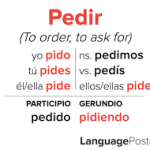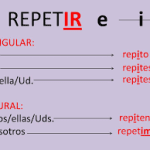Are you struggling to conjugate the verb ‘ponerse’ in Spanish? Look no further! In this article, we’ll show you how to easily conjugate ‘ponerse’ in various tenses and moods.
From the present tense to the imperative mood, we’ve got you covered. Whether you’re a beginner or just need a quick refresher, this guide will help you master the art of conjugating ‘ponerse’ in no time.
Let’s get started!
Regular Conjugation of ‘Ponerse
To conjugate ‘ponerse’ in Spanish, you need to use the regular conjugation rules. The verb ‘ponerse’ means ‘to become’ or ‘to get’ in English.
In the present tense, you’d say ‘te pones’ to mean ‘you become’ or ‘you get.’ For example, if you want to say ‘you become tired,’ you’d say ‘te pones cansado.’
In the past tense, you’d say ‘te pusiste’ to mean ‘you became’ or ‘you got.’ For instance, if you want to say ‘you got angry,’ you’d say ‘te pusiste enojado.’
Remember to match the verb with the subject pronoun to form the correct conjugation.
Practice using ‘ponerse’ in different sentences to enhance your understanding of its regular conjugation.
Conjugating ‘Ponerse’ in the Present Tense
You become or get in the present tense by using the regular conjugation rules of ‘ponerse’.
To conjugate ‘ponerse’ in the present tense, simply drop the -se ending and add the corresponding present tense endings.
For example, when addressing someone directly, you’d say ‘te pones’ to mean ‘you become’ or ‘you get.’
Similarly, when speaking about yourself, you’d say ‘me pongo’ to mean ‘I become’ or ‘I get.’
Remember to match the verb ending with the subject pronoun to ensure correct conjugation.
This way, you can express different actions or changes of state using the verb ‘ponerse’ in the present tense.
Conjugating ‘Ponerse’ in the Past Tense
To conjugate ‘ponerse’ in the past tense, you can use the regular conjugation rules and add the corresponding past tense endings after dropping the -se ending.
In the second person singular (tú), the past tense of ‘ponerse’ is ‘te pusiste.’ This means ‘you became’ or ‘you got.’
For example, if you want to say ‘you became tired,’ you would say ‘te pusiste cansado/a.’
If you want to say ‘you got angry,’ you would say ‘te pusiste enojado/a.’
Remember to match the gender and number of the adjective to the noun it describes.
Conjugating ‘ponerse’ in the past tense allows you to talk about past changes in someone’s state or condition.
Conjugating ‘Ponerse’ in the Future Tense
To conjugate ‘ponerse’ in the future tense, simply use the phrasal verb ‘vas a ponerte,’ which means ‘you are going to become’ or ‘you are going to get.’
This form of conjugation is used to express an action or state that will happen in the future.
For example, if you want to say ‘You are going to become a doctor,’ you’d say ‘Vas a ponerte médico.’
Similarly, if you want to say ‘You are going to get angry,’ you’d say ‘Vas a ponerte enojado.’
Remember to always use the verb ‘ponerse’ as the base and then add the appropriate conjugation of ‘vas a’ before it.
This way, you can accurately express future actions or states using ‘ponerse’ in Spanish.
Conjugating ‘Ponerse’ in the Conditional Tense
When conjugating ‘ponerse’ in the conditional tense, you’d use the preposition ‘te’ before the verb to express the action or state that would happen. For example, if you wanted to say ‘you would become tired,’ you’d say ‘te pondrías cansado/a.’
The preposition ‘te’ is used to indicate that the action or state is happening to you or referring to you.
The conditional tense is used to talk about hypothetical situations or things that would happen under certain conditions.
It’s formed by adding the endings -ía, -ías, -ía, -íamos, -íais, -ían to the stem of the verb.
Conjugating ‘Ponerse’ in the Imperative Mood
To conjugate ‘ponerse’ in the imperative mood, use the second person form of the verb and add the reflexive pronoun ‘te’ before the stem of the verb to indicate that the action is being done by you.
In the singular form, to say ‘put on’ or ‘become’ in a commanding way, you’d say ‘ponte’ which means ‘put on yourself’ or ‘become.’ For example, if you want to tell someone to put on their coat, you’d say ‘¡Ponte el abrigo!’
In the plural form, to command a group of people to put on or become something, you’d use ‘poneros.’ For example, if you want to tell a group of friends to put on their hats, you’d say ‘¡Poneros los sombreros!’
Remember to use the correct form of ‘ponerse’ and the accompanying reflexive pronoun ‘te’ when giving commands in Spanish.
Frequently Asked Questions
What Is the Meaning of ‘Ponerse’ in Spanish?
When learning Spanish, ‘ponerse’ means ‘to become’. It’s used to express a change in state or emotion. For example, you can say ‘te pones triste’ to mean ‘you become sad’.
Are There Any Irregularities in the Conjugation of ‘Ponerse’?
Yes, there are irregularities in the conjugation of ‘ponerse’ in Spanish. But don’t worry, I’ll explain them to you. Just keep reading and you’ll understand it better.
How Do You Conjugate ‘Ponerse’ in the Subjunctive Mood?
To conjugate ‘ponerse’ in the subjunctive mood, you use the same stem as the present tense but change the endings. For example, you’ll say ‘te pongas’ for ‘you put on’ in the subjunctive.
Can ‘Ponerse’ Be Used Reflexively With Different Pronouns?
Yes, ‘ponerse’ can be used reflexively with different pronouns. It means “to become” or “to get” and you conjugate it like any other -er verb, but with reflexive pronouns before the verb.
Are There Any Common Idiomatic Expressions That Use ‘Ponerse’?
There are many common idiomatic expressions that use ‘ponerse’. Some examples include ‘ponerse nervioso’ (to get nervous), ‘ponerse enfermo’ (to get sick), and ‘ponerse triste’ (to get sad).
Conclusion
In conclusion, conjugating the verb ‘ponerse’ in Spanish is essential for expressing states or changes in physical or emotional conditions. By following the regular conjugation patterns in the present, past, future, conditional tenses, and imperative mood, one can effectively communicate actions related to putting on or taking off clothes, becoming emotionally affected, or adopting a certain state of being.
Mastering the conjugation of ‘ponerse’ opens up a wide range of possibilities for expressing oneself in Spanish.


